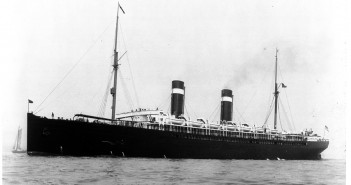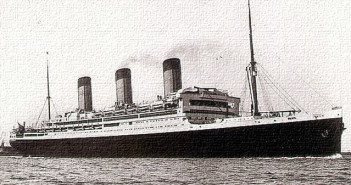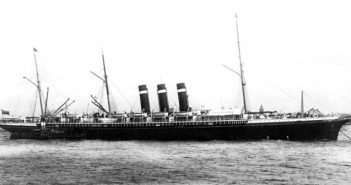Arabic (1881) was the first White Star liner built with a steel hull.
Launched on 30 April 1881, the 4,386-ton Harland & Wolff-built liner was 430 feet long and 42 feet at beam. She featured one funnel, a single screw and four masts, including a sail-bearing foremast. Arabic was capable of cruising at 13 knots.
The liner needed her sturdy hull on 2 December 1881 when she collided with the steamer Plove while leaving Liverpool on the last of three New York roundtrips before entering Pacific service under charter to the Occidental & Oriental Steamship Co. Thanks to her sturdy hull, Arabic suffered only minor damage in the collision and would begin serving a Hong Kong-San Francisco route in early 1882.
Like her sister ship, Coptic, which was launched later in 1881, Arabic was built to serve as a combination cargo/passenger liner. Nonetheless, although she could accommodate both steerage and second-class passengers, Arabic was primarily designed to carry cargo and livestock.
In early 1887, her charter completed, Arabic sailed to Belfast for the addition of 50 second-class berths. The liner resumed sailing for White Star Line in March 1887, serving a London-Queenstown-New York route. In May, she was switched to White Star’s high priority Liverpool-New York run, which she served until April 1888. Shortly thereafter, she resumed her Occidental & Oriental charter.
In February 1890, Arabic was sold to Holland-America Line for £65,000 and renamed Spaarndam. For more than a decade, she served a Rotterdam-New York route. She went to the breakers in 1901, steel hull and all.
The story below, which appeared in the 29 August 1881 issue of the Liverpool Mercury, provides a detailed description of Arabic as well as White Star Line’s growing partnership with shipbuilders Harland &Wolff.

Please help keep Ocean Liners Magazine afloat. Any amount will be greatly appreciated.
—Regards, John Edwards, Editor/Publisher.




